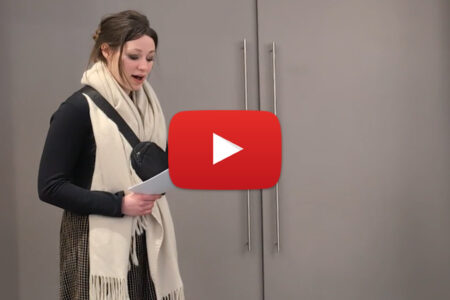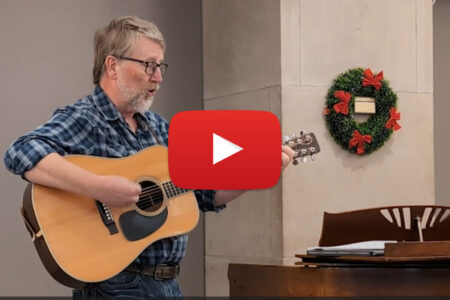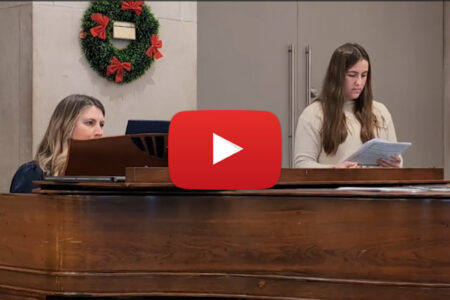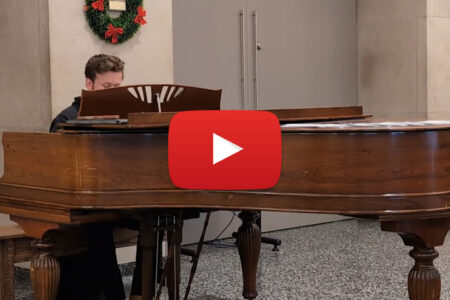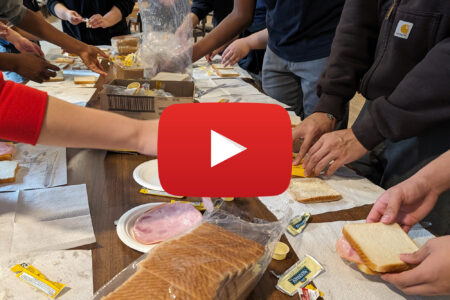St. Mike’s Lunar New Year celebrations gave students a taste of home. The festivities were organized by St. Mike’s Student Union’s International Outreach Committee and the Office of Campus Ministry and held in the COOP on January 30.
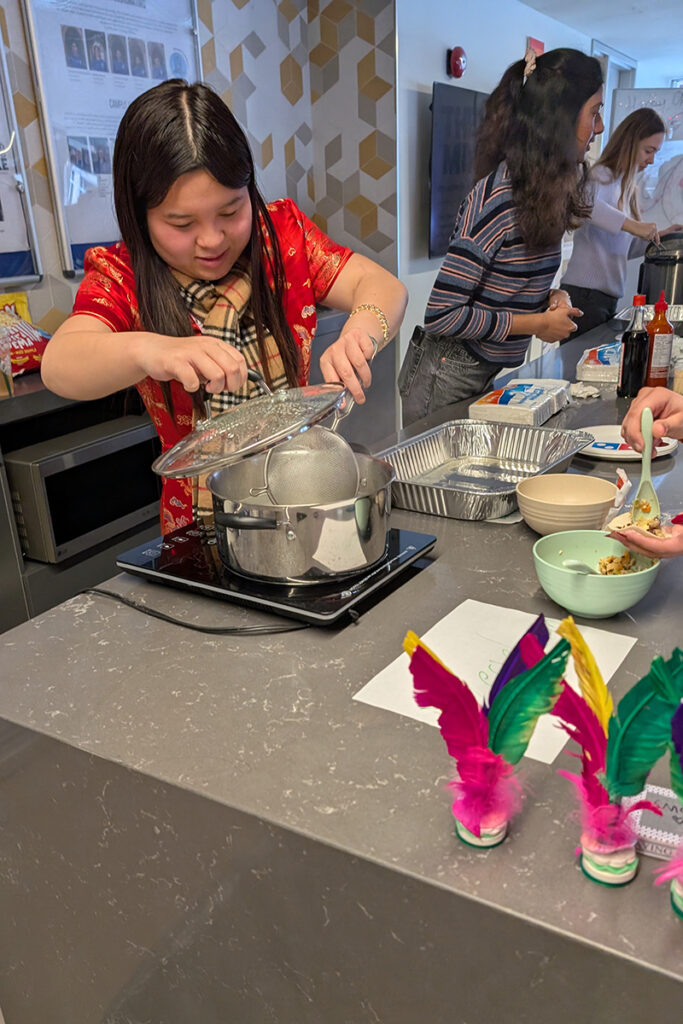
The event brought together those whose traditions include those marking the Lunar New Year while introducing those less familiar with the occasion to the rich cultural celebrations. The experienced and less experienced alike were invited to try Chinese Mongolian calligraphy; Chinese paper cutting; dumpling making; and Jianzi, a traditional Chinese sport similar to hacky sack but instead of a ball uses a weighted shuttlecock.
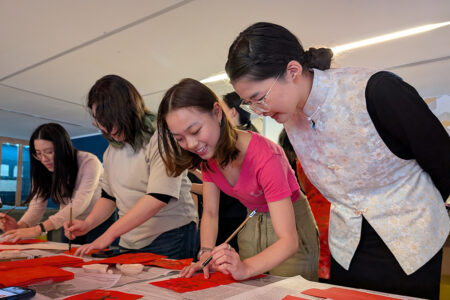
“Today’s been really nice because I feel like it’s a networking event where you can get to know people from similar cultures,” says Vanecia Lai, a first-year humanities student. She practiced her calligraphy by writing academics, hoping it would bring her fortune in this area in the coming year, while Emrys Chang, a first-year humanities student, wrote puns related to the year of the snake.
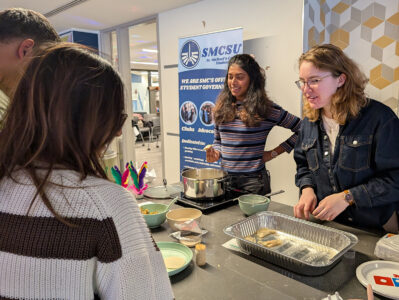
“I’m still getting used to life in Canada and today made me feel like I’m back home,” says Sherry Yang, a first-year humanities student who’s celebrating in Canada for the first time. She enjoyed making dumplings because it reminded her of being with family when they would make dumplings together to eat at family reunions.

For Valeria Velazquez, a first-year economics student, writing calligraphy took her back to her childhood when she and her grandfather, who was Chinese, would practice calligraphy in Mexico. “This reminds me of him in a really good way, but we stopped his traditions once he passed away,” she said. “It’s been nice to connect with other people that have similar backgrounds,” she says.
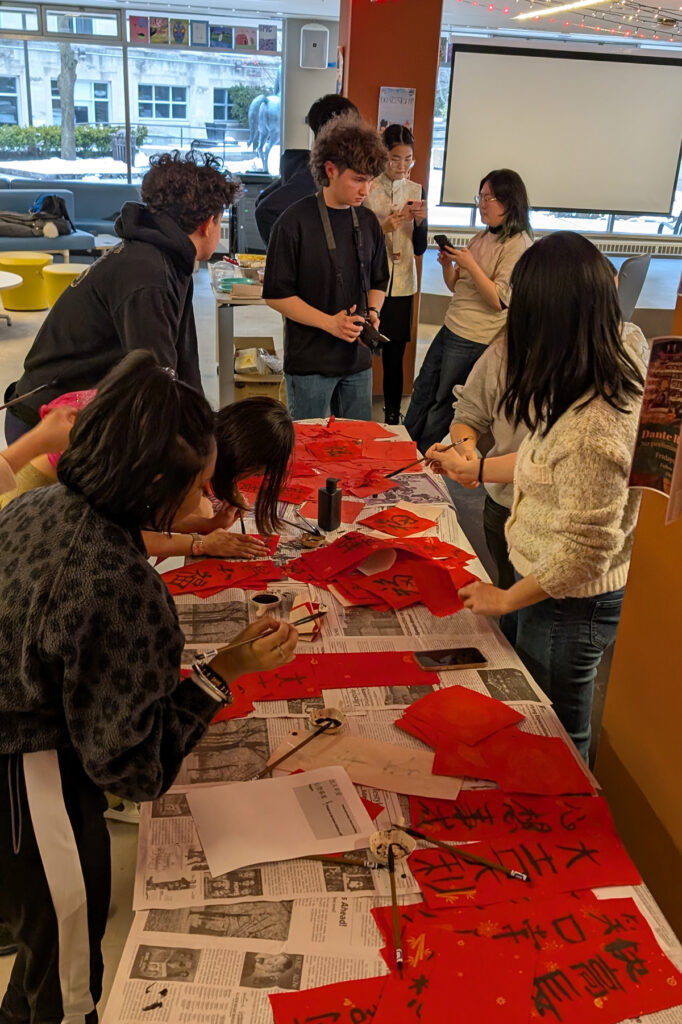
Dia Bulgankhangai is a first-year international student from Mongolia and, as a member of the International Student Union, she helped plan the event. “I was surprised to find out that Mongolia wasn’t the only country that celebrated the Lunar New Year. It’s been very nice getting to know more about Chinese culture and seeing the differences between my culture and Chinese culture. We celebrate quite differently, but we still share some of the same traditions: we have a meal, we see our family and we play games,” she says.
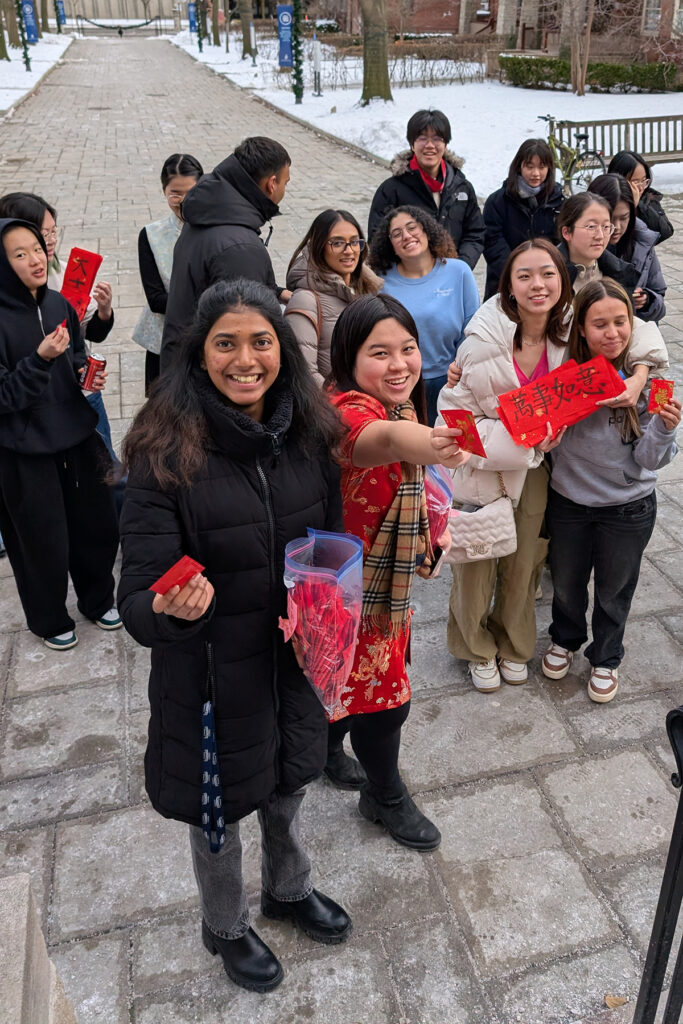
The festivities moved outdoors where participants received a red envelope to wish them good luck and prosperity in the new year and watched a traditional lion dance performed by dancers from the Wushu Project.

“U of T is a big school, and SMC is a big college too, so it’s very easy to feel left out, especially as an international student. I felt welcomed by the SMC community today,” says Dia.
Whether you’re missing your own family traditions or want to learn more about one of the largest cultural practices in Southeast Asia, St. Michael’s students are invited to celebrate the Lunar New Year on campus. The festivities, organized by the St. Michael’s College Student Union (SMCSU) and Office of Campus Ministry, will take place on Thursday, January 30 from 3 – 5 p.m. in the COOP.
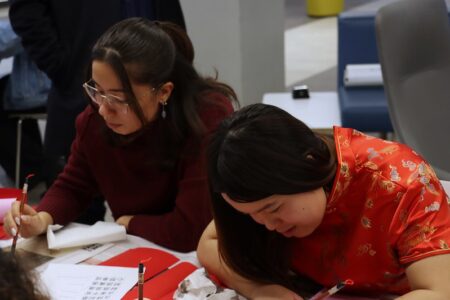
“I hope that students who are celebrating Lunar New Year, as well as those who may be less familiar with the traditions, can come together to learn more about a rich culture,” says the event’s organizer, Candy Hua. “My vision for these celebrations is to foster cultural understanding and exchange, welcoming all members of the community to participate and appreciate the diversity that enriches our campus. By engaging in this celebration, I hope we can strengthen ties among students, promote mutual respect, and create lasting memories that celebrate our shared experiences and values.”
Candy is a third-year political science and history student and is an Interfaith Campus Minister and member of the SMCSU’s Spiritual Life Committee. She knows the role of upholding traditions can play in maintaining one’s identity and making them feel at home.
“I recall during my first year in 2022, I was in my dorm at Loretto, watching the celebrations and the lion dance from my window overlooking Brennan Hall. At that time, I hadn’t yet fully come out of my shell, but witnessing the vibrant festivities inspired me to get more involved in the community. This motivation drives me now as I take on the responsibility of organizing this event, eager to contribute to something that brings joy and unity to our campus,” she says.
As part of the celebrations, there will be a lion dance at 4:30 p.m. The lion dance is a vibrant and traditional performance integral to East Asian and Southeast Asian cultures, particularly during celebrations like the Lunar New Year, weddings, birthdays, and grand openings. Characterized by its dynamic movements and elaborate costumes, the dance features two performers who mimic a lion’s behavior, accompanied by rhythmic drumming and traditional instruments. Symbolizing strength, good luck, and the dispelling of evil spirits, the lion dance serves both a celebratory and ritualistic role, inviting prosperity and positivity into homes and businesses.
St. Michael’s festivities will also include a range of cultural and hands-on activities to engage and immerse participants in the Lunar New Year festivities by expressing their creativity and learning about traditional art forms.
Featured activities include:
Chinese Mongolian Calligraphy: This art form allows participants to delve into the beauty of written Chinese characters. By learning calligraphy, attendees not only grasp the techniques of brush strokes but also connect to an ancient tradition that embodies cultural heritage and history. This mindful activity encourages creativity while fostering appreciation for the nuances of the Chinese language.
Chinese Paper Cutting: As a cherished folk art, paper cutting is often adorned with intricate designs symbolizing good fortune and happiness, particularly during the Lunar New Year. This activity presents an opportunity to explore the cultural significance of various motifs while promoting patience and dexterity. Participants will not only create beautiful artworks but also gain insights into the rich traditions that accompany these vibrant celebrations.
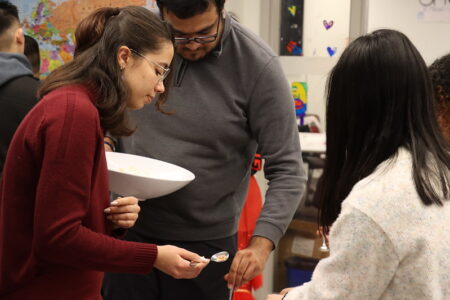
Dumpling Making: Dumplings are synonymous with Lunar New Year festivities, symbolizing wealth and prosperity. During this hands-on activity, participants will not only learn how to make these delicious treats, but also appreciate the communal aspect of food during celebrations. This experience highlights the importance of family gatherings in Asian culture and fosters teamwork while creating a tasty connection among participants.
Ping Pong / Jianzi: Incorporating physical activities add an element of fun and social interaction to the event. Jianzi is a traditional Chinese sport where players try to keep a weighted shuttlecock in the air by kicking it and both sports are popular during Lunar New Year celebrations. These games enhance camaraderie and create a lively atmosphere, making the celebration enjoyable for everyone involved.
And spoiler: everyone who attends will receive a red envelope with a surprise inside. This traditional gift symbolizes good luck and prosperity, making it a meaningful token for participants.
Gong hei fat choi!
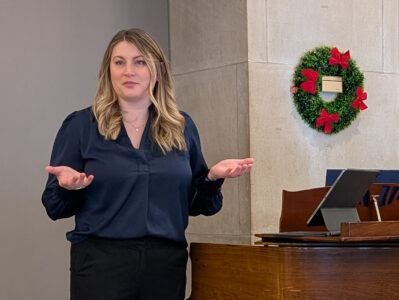
A deep desire to write and share music brought together students, teachers and liturgical musicians to the Sacred Music Workshop hosted by St. Michael’s College and Emmanuel College on November 30.
Bringing a range musical experience and songwriting styles more than 40 participants gathered in Charbonnel Lounge for a glimpse into the hymn writing process. The workshop was facilitated by Kate Williams of GIA Publications and included a hymn writing session followed by a choral reading. “GIA Publications publishes sacred music with a number of new titles every year. We offer these sessions to introduce our new music. By offering these workshops, the music comes off the page so participants can have an experiential encounter rather than just seeing it on a piece of paper,” said Kate.
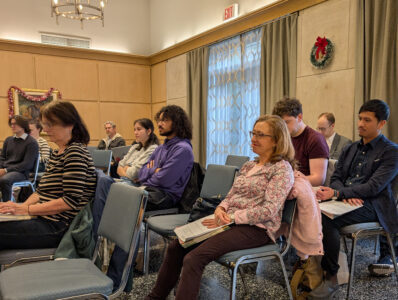
As a part of the workshop, participants were invited to submit a text and tune in advance. Each of the submitted works was sung with accompaniment and participants were invited to offer their constructive feedback. The composers introduced their pieces and spoke about their inspirations that ranged from creation and personal experiences to people and Biblical texts.
Aisinn Nowelle graduated from Emmanuel College and has had a piece published previously by GIA Publications. She submitted a new piece titled ‘God is my Shepherd’, dedicated to her pastor in celebration of his retirement, to be workshopped at the session.
“Hymns formed the base of songs that I grew up with and now I feel that with more contemporary songs being written, there’s fewer hymns being written for today’s context. I think it’s nice to have songs that sound like hymns but are fresh and accessible,” she says.
Jim Kuhn is a self-taught songwriter and has been writing songs for his congregation since the 1970s. He came to the workshop to get an outside perspective on his work.
“It’s a bit of a challenge presenting in front of people who have way more music theory knowledge than I do. I wanted to come to figure out if what I’m writing has any relevance. I decided to take the opportunity to get some feedback and see if I’m at least going in the right direction,” he says.
For Jenna Smith, who submitted her piece titled ‘Gently Lead Us’, it was her first time sharing a piece widely.
“It’s the first time I’ve heard this piece live and it was exciting. I’ve learned some things and I’m going to tweak some things for the future, but the experience was very educational and fun,” she says.
Rob Cretney submitted his hymn titled ‘I Am’. Having grown up in a Christian family, he was familiar with hymns, but this was his first time writing one. He is in his final year studying music at Wilfred Laurier University and interested in learning more about the programs at St. Michael’s.
“I’m at the stage where I’m just taking as much feedback as I can and it was super helpful,” he says.
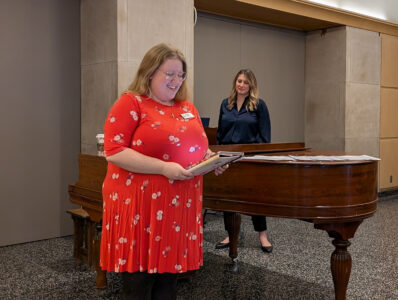
Kate enjoys leading the workshops at St. Michael’s and thanks Christina Labriola, Sonal Castelino and the Campus Ministry team for the hospitality they show GIA Publications each year. “Charbonnel Lounge is the perfect space for this gathering, and I jump at the chance to make some really good music together and get to know everyone in a warm and comfortable setting,” she says.
Sonal Castelino has been named the inaugural Director of Mission and Ministry for the University of St. Michael’s College, with a mandate to guide the integration of St. Michael’s mission, vision, and values into the life of the university. Reporting to the President and as a member of the senior leadership team, she will also continue to provide leadership for the community’s religious, spiritual, and liturgical life.
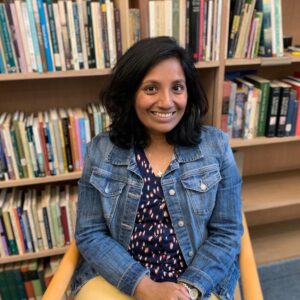
Sonal’s focus, inspired by Catholic Social Teaching, will include working with colleagues across the university to further weave a strong emphasis on equity, diversity, and inclusion into the university community, to increase the emphasis on climate and social justice, as well as to nurture a general sense of belonging.
A Catholic university “has something significant to offer to the institutional Church,” says Sonal, who assumes her new role August 1. “The very life of the university is creative and relational as students and faculty wrestle with finding meaning and their way in the world. We are the perfect place to engage in this challenging and rewarding work: weaving in faith and a deeper commitment to the common good.” While continuing to oversee Campus Ministry, as Director of Mission and Ministry, Sonal’s scope will be broadened to include such duties as creating opportunities for students, staff, and faculty to engage with the university’s mission and Catholic identity – for example, arranging staff retreats and organizing conversations on how to cultivate the university’s mission.
She will also serve as a liaison to various institutional partners, from Catholic school boards and the University of Toronto’s Multi-Faith Centre to religious communities and the Archdiocese of Toronto, strengthening relationships and finding opportunities for collaboration and experiences for students.
Citing a strong tradition of student leadership at St. Michael’s, Sonal is keen to encourage and empower students to envision themselves as agents of positive change in the world.

“I want our students to recognize leadership potential within themselves. I want to equip them to ask themselves what it means to be a leader—first at St. Mike’s, and then in the broader world—all of this rooted in a deeper desire to serve and engage with the complexities of our world today.”
University President David Sylvester says this new role will help expand understanding of St. Mike’s 180, the university’s strategic plan.
“I have watched the extraordinary impact Sonal has had on revitalizing Campus Ministry, which includes bringing back the much-loved student Mass and building a vibrant student team reflective of the unique and diverse nature of St. Michael’s,” says President Sylvester. “In this new role, Sonal will bring that level of energy and engagement to strengthening partnerships, educating community members on the significance and importance of our mission, and offering opportunities to students, faculty, and staff for personal and spiritual enrichment. I am excited to see where her leadership takes St. Michael’s.”
After receiving her Bachelor of Commerce degree from the University of Toronto, Sonal earned a Master of Divinity degree at Regis College.
Before joining St. Michael’s in 2021 as Director of Campus Ministry, she worked first as the Associate Director of Formation and Programs at the Newman Centre Catholic Mission at the University of Toronto, and then as Student Life Coordinator at Regis College.
A day of service brought 90 high school students to St. Mike’s campus to gain an understanding of what it truly means to serve. Grade 11 and 12 students from nine high schools in the Toronto Catholic District School Board answered the call to be a part of the ‘A Catholic Call to Service’. The day, led by the St. Michael’s Campus Ministry team, was designed to show high school students how small acts of service can make a big difference.
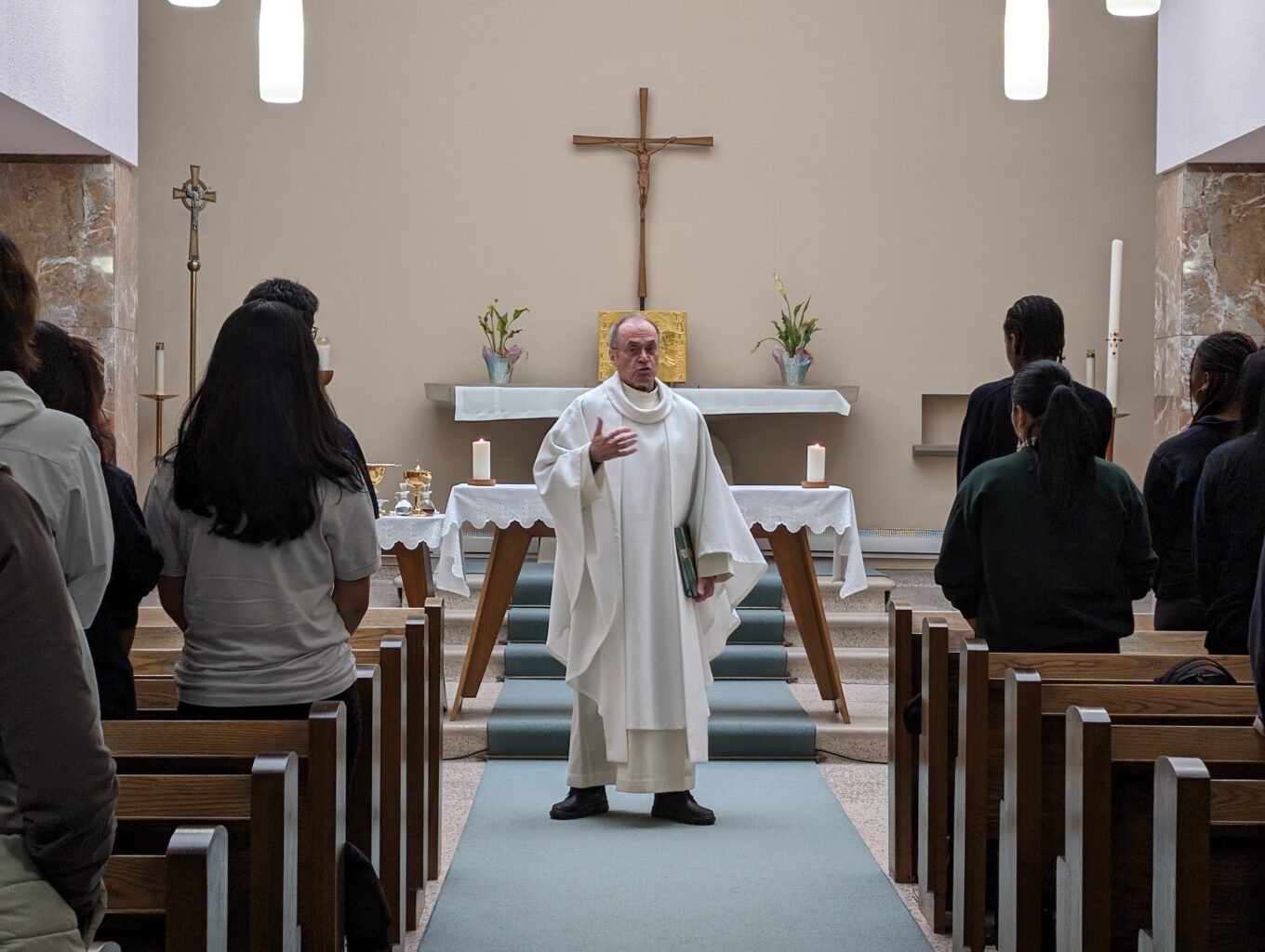
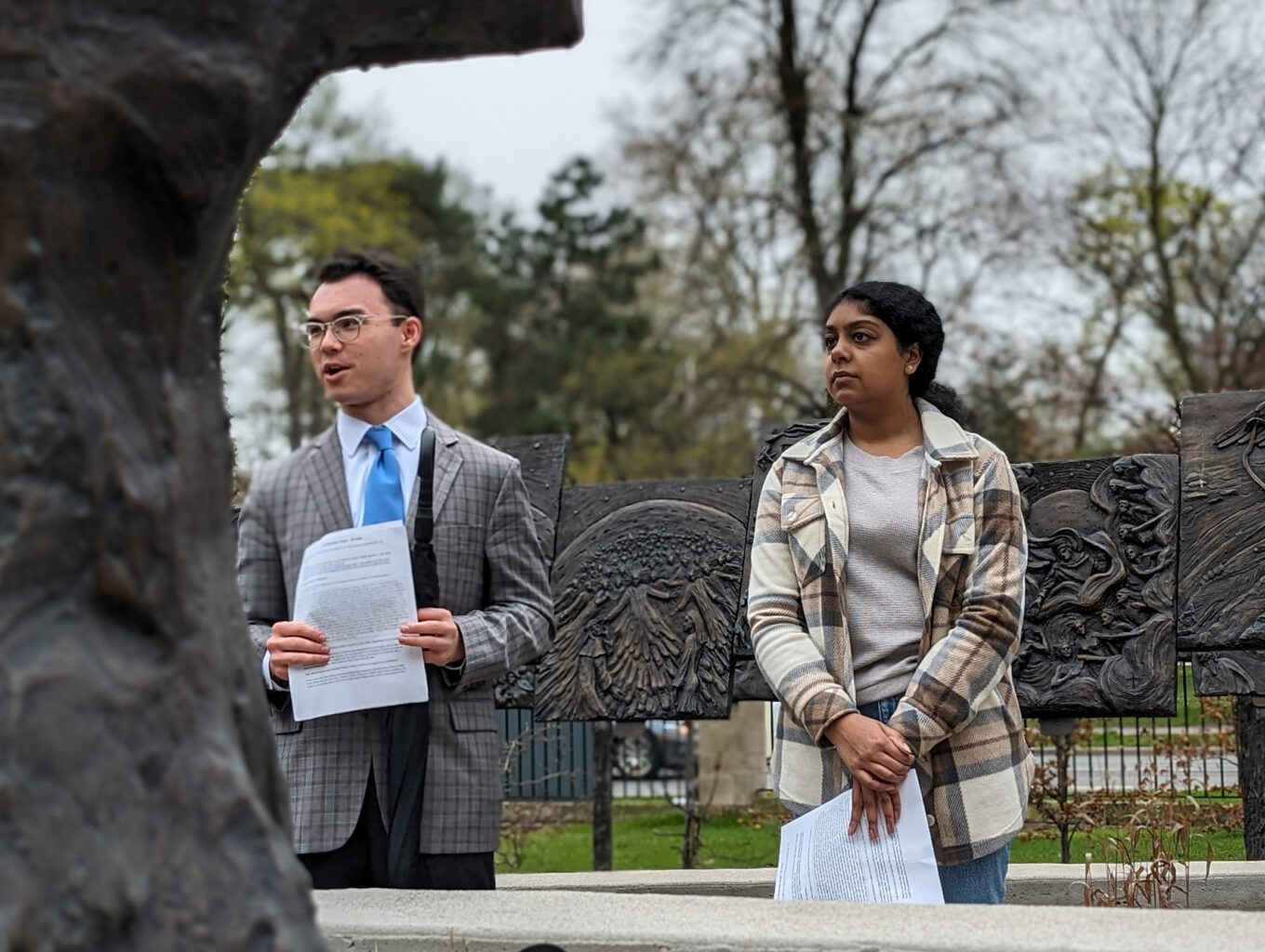
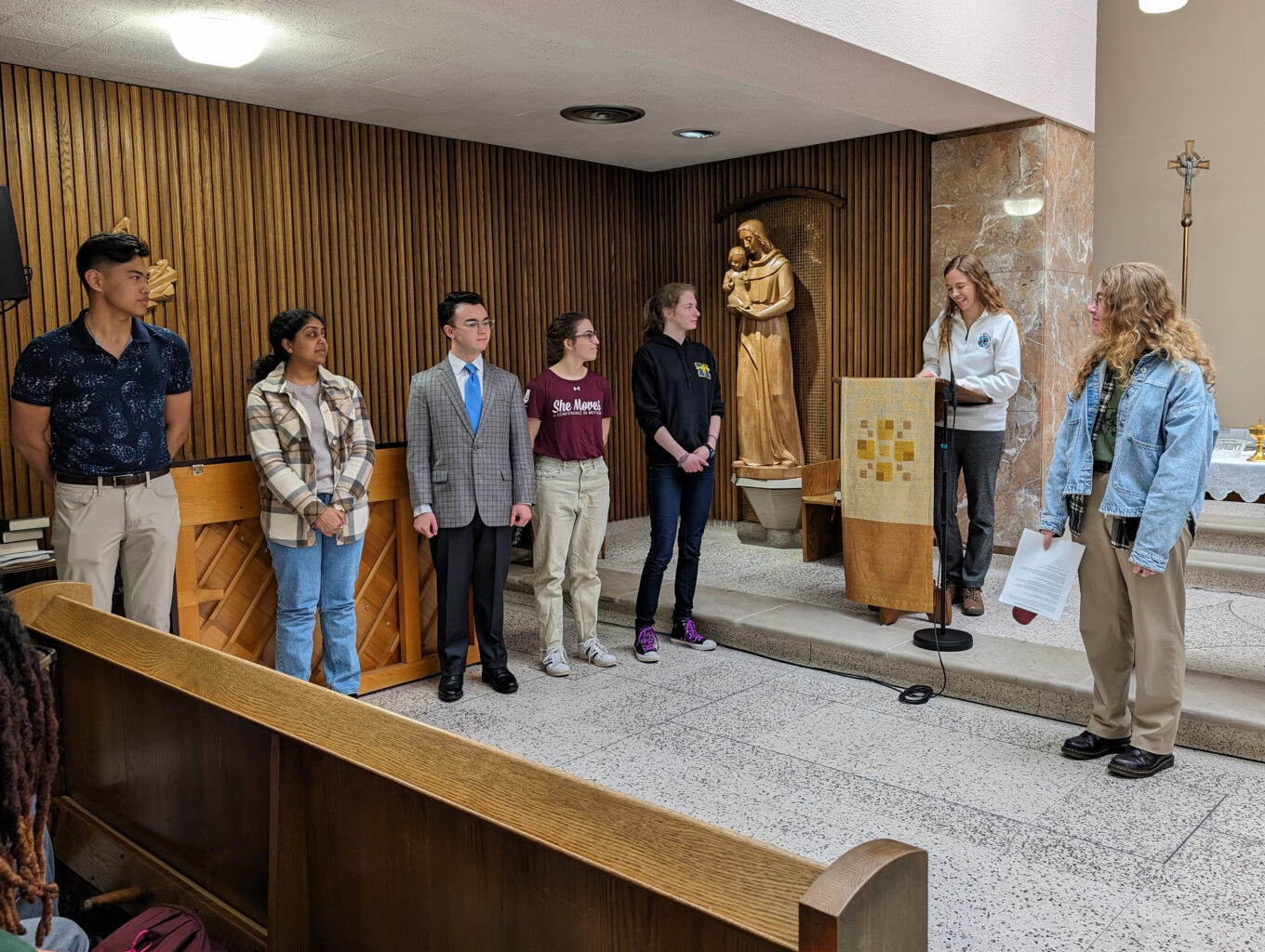
“The stops at the Timothy Schultz pieces provided a nice opportunity to reflect on what we’re doing here today,” said Lisa Malcolm, who organized the day through her work at the Catholic Teachers’ Centre at the school board’s Nurturing Our Catholic Communities.
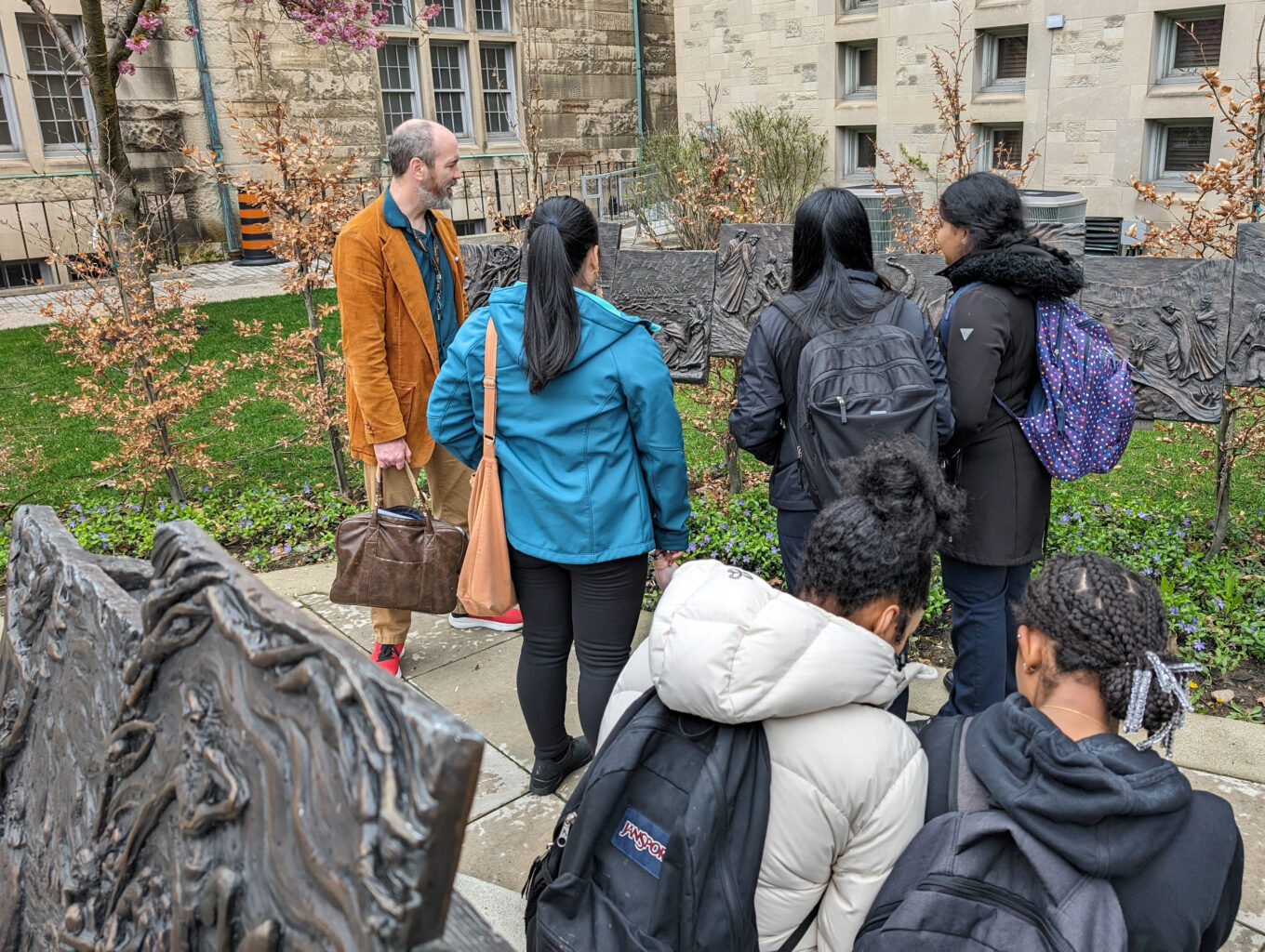
“We had a good response to Let the Oppressed Go Free because there are lot of details that the students were pulling out like a child bride or a child holding a gun. At one point we asked the group, ‘Where are they pointing to?’ And one of the teachers said, ‘Well the government buildings are right there. They are kind of reaching to the government buildings.’ That was interesting for me as it’s like the work is asking ‘What can the government do about these issues?'” said Lydia Dillenbeck, a campus ministry volunteer who is going into her third year with a double major in music and sociology.
The high school students also assembled sandwiches that were packed into paper bags to be distributed to those in need.
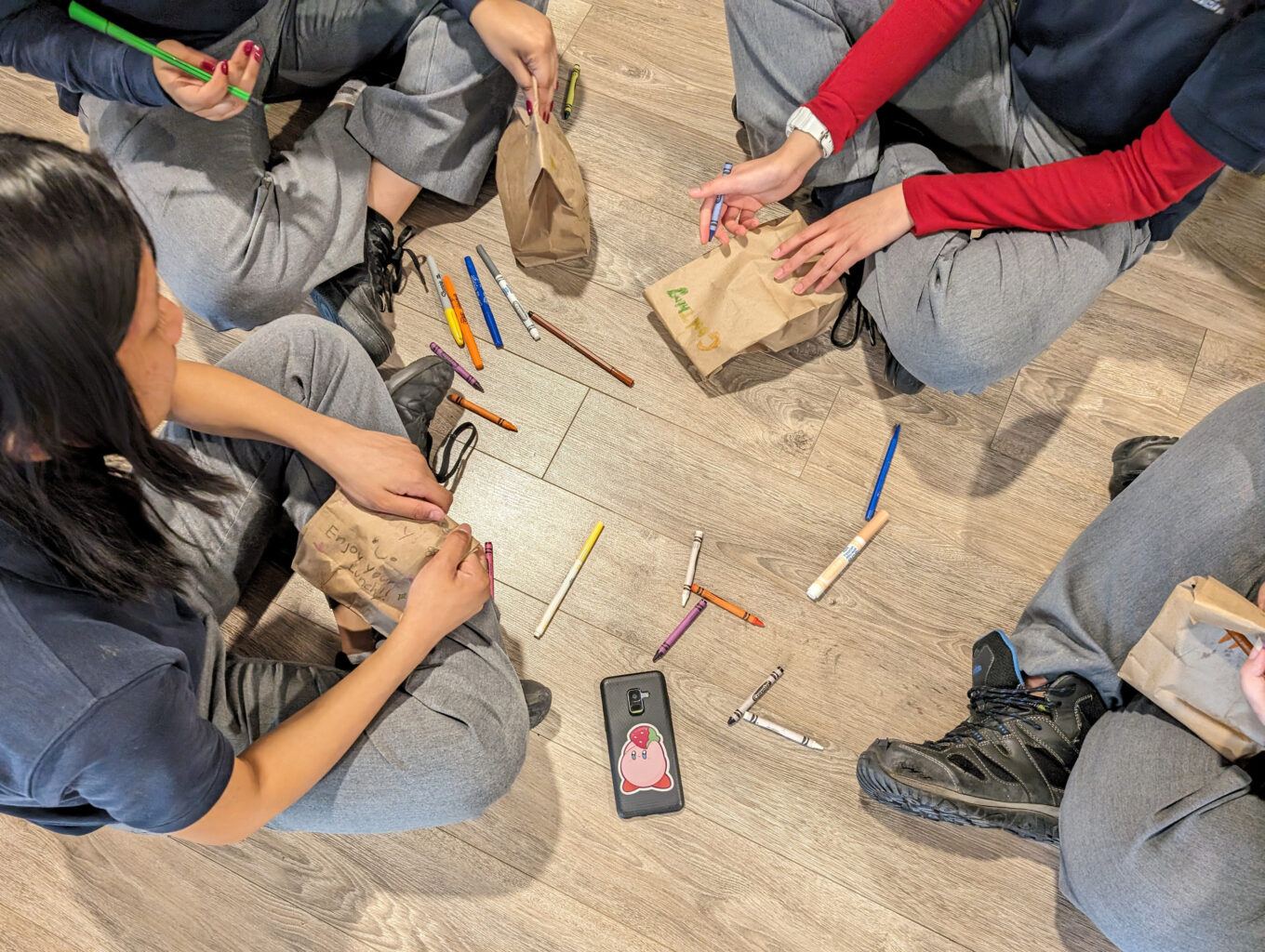
“Something I was reflecting on today as I saw teenagers volunteer to come out today was that this wasn’t something I did in high school. Now being in university and being more involved, I’m seeing the value in it. It’s inspiring that these students see the value so early,” said Bridget Bowles, who will be entering her third year and majoring in English with minors in Christianity & Culture and Mediaeval Studies

Anita Rajkumar is a third-year student completing a Health and Disease Specialist. She is the Community Service and Outreach Coordinator on the Campus Ministry Team at St. Michael’s College. In addition, she is a Senior Mentor on the St. Michael’s College Mentorship program. She enjoys reading and volunteering in her free time.
When red- and green-coloured ornaments are displayed in store windows, holiday songs play on the radio, and Starbucks brings out their selection of winter drinks, you know it’s the Christmas season.
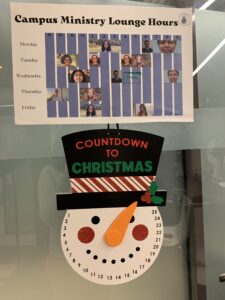
Christmas is defined as a period of joy and happiness that individuals look forward to during the winter season, as it is a time when families come together to make new memories while reminiscing about old traditions. The holiday provides a sense of belonging for individuals of diverse ethnic backgrounds, as it does not require religious knowledge to celebrate, but rather a good spirit. Living in a multicultural city like Toronto, we get one of the best Christmas experiences as it overlaps with traditions of a variety of religious and cultural events.
The Christmas season traditionally begins at the start of Advent, but in western societies, commercialization pushes the date forward to the first week of November. Big box stores begin selling Christmas trees, ornaments, wreaths, and outdoor decorations early in the season to capture the attention of shoppers who would like to decorate their homes. Black Friday has been advertised as a day to purchase gifts for loved ones at a lower price, emphasizing the importance of gift exchange during the holiday season. Although religious views of Christmas do not focus on the concept of gift exchange, this gesture involves individuals expressing kindness and compassion to one another. When I purchase a gift for a family member or friend, I often think about the qualities of the person in order to find the most suitable gift. I purchase the gift to show my sense of gratitude towards the person, rather than expecting a gift in return, which is the true spirit of a holiday season that combines religious and secular views.
God gave humanity the ultimate gift, his son, the Saviour, Jesus Christ. On the Campus Ministry Team, we respond to God’s vocation by collecting toiletries and non-perishable donations for homeless shelters within the GTA during the holiday season, allowing all students to participate in the act of giving regardless of their religious background.
The beauty of Christmas is that there are no mandatory traditions tied to the holiday, which makes it easy for people to adapt and invent new traditions. My family begins decorating the Christmas tree early in November, as we enjoy observing the bright lights and ornaments early in the season, which contrasts with those who begin decorating once the Advent season begins. Stockings hang off the fireplace while nutcrackers, snow globes, and garlands fill my household. Placing the wreath on my front door symbolizes my family’s cultural identity and reminds me of how fortunate I am to live in a city that provides me with the freedom to participate in cultural events. Every year, my sister and I decorate gingerbread houses while watching classic Christmas movies like “Home Alone” and “Elf” on Christmas Eve. A tradition in my family that has been passed down for many generations includes making Sri Lankan Christmas cake, which is a decadent dessert that is made with candied fruits, nuts, rose water and brandy that must be made many weeks in advance to Christmas. Social gatherings are a central part of the holiday season so on Christmas day we exchange gifts and have a holiday meal with the extended family.
There are many opportunities to experience the Christmas season within the Greater Toronto Area. Every winter, the Distillery District is transformed into the Toronto Christmas Market, which provides an old-charm, European experience without leaving the country. The Cavalcade of Lights at Nathan Phillips Square is a must-see destination to experience the holiday lights, annual tree lighting ceremony, and go ice skating. Winterfest at Canada’s Wonderland is a similar event that is becoming increasingly popular. The Hudson’s Bay Holiday Windows at the Eaton Centre was a childhood favourite of mine, as it displayed Santa Claus and his elves preparing for Christmas. Unfortunately, the window displays have been updated since then, but it is still an iconic display. The annual Santa Claus Parade brings the community together onto the streets of Toronto, where people sing holiday carols and enjoy observing parade floats while collecting donations for a good cause. Recently, there have been parade floats with Chinese dragons and Indigenous symbols, representing the diverse communities within the city. These events provide a western perspective of the Christmas season that all individuals can engage in, despite their various denominations.
Here at the University of St. Michael’s College, we embrace the religious and secular values of Christmas by hosting a variety of events students can participate in, which include gingerbread cookie decorating events, Christmas dinners, Christmas markets and a Mass at St. Basil’s Parish. These events often support vulnerable communities within the city, allowing students to bring joy to people in need.
Ultimately, I believe Christmas in Toronto is more than a religious—or secular – moment but is a time for us to come together as a community, regardless, to celebrate the love we have for each other through selfless acts.
St. Mike’s is accepting donations for Out of the Cold’s Christmas Food Drive. Please bring your non-perishable food items to the donation box on the main floor of the Kelly Library and in the Campus Ministry Lounge (Brennan 101) any time between now and Dec. 16. Also a reminder that proceeds from the Christmas Market (Dec. 8) will go to this year’s winter charities, St. Basil’s Out of the Cold and Romero House. You can also make an online donation using this form: https://stmikes.utoronto.ca/christmas-drive-2022.
Read other InsightOut posts.
A community Mass on Saturday evenings, a variety of multi-faith celebrations, and working with the marginalized people of Toronto are some of the many ways a revitalized campus ministry will be offering diverse programming and activities for the St. Michael’s community this academic year.

“There are three areas of growth for us,” explains Campus Ministry Director Sonal Castelino, xmcj. “We want to give students who are curious about the Catholic faith, or who want to deepen their spiritual life, opportunities such as a Scripture discussion group, regular prayer gatherings, or the chance to help with the music ministry at the Saturday Masses. We also want to offer inter-religious and inter-cultural events, providing the chance for engagement and celebration with the broader community, and we want to engage in a variety of social justice initiatives.”
And, Castelino emphasizes, as she now has a team of a team of eight student leaders in place, these activities will offer students an opportunity to work with other students, empowering them and helping them find and develop their own voices. The team includes two members dedicated to interfaith activities, two members focussed on social and community outreach, two to retreats and faith formation and two expressly dedicated to Catholic faith formation.
“There is a calling for campus ministry to offer a niche in the very busy lives of students. We want to make a connection between the campus and the city, whether with the vulnerable or with a variety of faith and cultural traditions,” she explains. “We want Campus Ministry to become a space where all will feel welcome and that they know they belong. There is a very real comfort level in our college about being open to exploring spirituality and faith. Caring for the whole student means accounting for this dimension of their campus experience as well.”
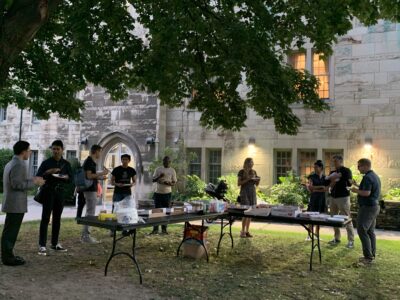
A core aspect of Campus Ministry’s offerings with be newly scheduled Student Mass, to be held Saturday evenings during the academic year at 6:30 in St. Basil’s Church. Students will have the opportunity to sign up to serve as lectors or for the music ministry, and to join in a meal with other community following Mass. Celebrants will include various priests from the University community.
For more social connections, Campus Ministry also has a new drop-in lounge, located in Brennan 101, a quiet place for connection, as well as for team members to do their work.
Campus Ministry will also offer a range of social justice initiatives, with opportunities such as visiting long-term care facilities and homeless shelters designed to offer hands-on help while also gaining an education in systemic challenges in society.
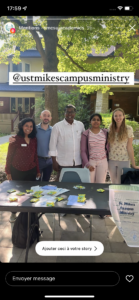
As well, the team will be involved in offering support to a range of faith traditions seeking to mark important dates in their calendars, while also hosting cultural events for special moments throughout the year such as the Hindu festival of Holi and Chinese New Year.
Finally, another development this year is off-campus retreats. Since the community spent a lot of time indoors and isolated during the pandemic, Campus Ministry will offer two opportunities for students to head off campus for a weekend, taking the time to pray, reflect, and build friendships.
“Campus Ministry should be a place that allows us to hold a mirror to ourselves showing the depth and diversity that is our college campus. We invite people into a deeper relationship with themselves, each other and God, creating space to explore different ways of being, which helps to build community, and lends support as we gain the courage to ask questions,” Castelino observes.
Campus Ministry events can be found on its Instagram account – @ustmikescampusministry – with a web page to follow.
Sonal Castelino, Director of Campus Ministry, writes:
This Lenten season, Campus Ministry organized a retreat for students to find inner peace through an intentional and personal friendship with Jesus. This was an opportunity, an avenue – amidst the busyness of the academic term, the stress or the newness around the return to on campus learning, the helplessness in front of the war in Ukraine—to stop a moment and connect to that which is essential: finding grounding and depth in the spiritual life and thus hope and strength to persevere and continue.
The format of the retreat included committing to daily prayer for 30-40 minutes and a time for spiritual conversation weekly to unpack the prayer experience as a group and listen to each other over five weeks.
The retreat is inspired by the Spiritual Exercises of St. Ignatius of Loyola and the format we used was proposed by Michael Hansen, an Australian Jesuit who created a community through the First Spiritual Exercises.
To ensure accessibility, we offered this retreat both in person and online with facilitators to guide and move the retreat along with the participants. The experience has been a very fruitful one.
Here is the experience of Paul Kye, a doctoral student at St. Michael’s Faculty of Theology:
Sitting in solitude, I found myself interacting with Jesus one day, who had been waiting for my friendship and wholesome acceptance. I was introduced to this retreat couple of days later, and I have been participating it on my own every day. This journey has been life-changing, both in interior and external levels of my life–how I see this world and how I see myself. I emerge in prayer and meet Jesus, who appears to me at levels appropriate for my own level of spirituality, I feel so much love and attention, consolation and encouragement that I have needed. Sometimes I see him as a teacher, as the Creator or a friend who takes my own yoke in exchange of his light one, instills an enlightening understanding and newly nurtured love for my own cross to bear, and most of all, breathes in lifegiving joy and excitement in my heart to face the daily life. This exercise has transformed me, as I dedicate a specific set of time to it every day, it allowed to me to see my life not according to my own will or those of others, but according to God’s will.
Read other InsightOut posts.
Sr. Sarah Rudolph is a Loretto Sister and the director of the Mary Ward Centre, a ministry of the Loretto Sisters focused on education, justice and spirituality. One of her areas of work is children’s rights advocacy, including the rights of girls and fostering girls’ participation at the United Nations through the CJ/IBVM NGO to the UN. She has a deep love for Ignatian spirituality and shares it through a monthly women’s prayer group and outreach to women who have experienced homelessness through the Ignatian Spirituality Project.
Motivated by Love
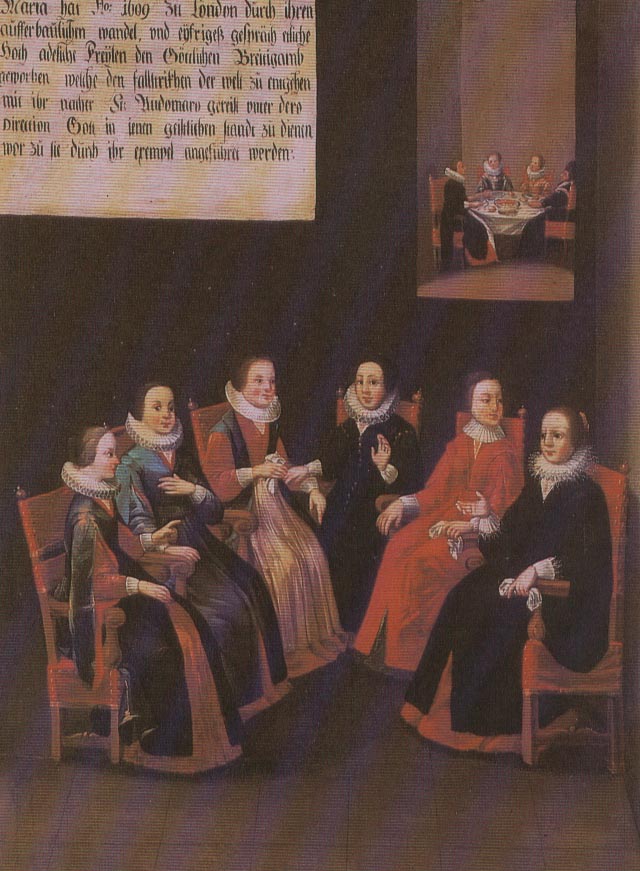
“I was so apt for friendship and ever loved more than ordinary.”
These words of Mary Ward (1585–1645), founder of the Congregation of Jesus and Institute of the Blessed Virgin Mary, commonly known as the Loretto Sisters, written in the 17th century, have a rich resonance for her companions today. As a member of the Loretto Sisters, these words remind me that Mary Ward Women are relational women committed to a deep relationship with God and others, motivated by love, as the driving force that urges us on in mission. Mary’s capacity for loving friendship, and for working with others for the sake of mission, offer an enduring inspiration.
Her early companions were diverse. They are often remembered in this image from The Painted Life of Mary Ward, the open circle of friends—(right to left) Mary Ward, Winefrid Wigmore, Susanna Rookwood, Catherine Smith, Jane Browne, and Mary Poyntz. These women were the first to join her in religious life, however, her circle of friends extended far beyond the members of her Institute, and included religious and political figures, and members of European monarchy. Among her closest companions were her dear friends, Robert Wright and Henry Lee (Lee referred to Mary as his “best friend”), who journeyed with her from Flanders, across the Alps, to Rome.
What does Mary Ward’s extraordinary capacity for love and friendship have to do with the Loretto Sisters and their relationship with St. Mike’s?
The bond of love and friendship for mission and service to the Church, the academy, and the common good, has existed between the Loretto Sisters and St. Mike’s for over a century. The establishment of Loretto College, from its first foundation at the Loretto Abbey Motherhouse on Wellington Street to the residence building today on St. Mary Street, is closely connected to the evolution of St. Mike’s.
In January 1911, a historic federation between the Congregation of the Sisters of St. Joseph, St. Michael’s College, and the Loretto Sisters was formed to create the official Catholic College of the University of Toronto. The Loretto Sisters provided not only a residence for women pursuing advanced education but also professors for Classics, Modern Languages, and Philosophy classes which were given in their own College building. The motto of Loretto College, Veritas fons Lucis et Caritas, or “Truth is the source of light and charity” complements the Basilian motto of St. Mike’s, Bonitatem et disciplinam et scientiam doce me, which means “Teach me goodness, discipline and knowledge.” Our institutions are committed to education for the good of the human person, for the Church, and for the world. We strive to form men and women who pursue truth, are dedicated to the attainment of Christian virtue, and are able to meet the challenges of the contemporary world.
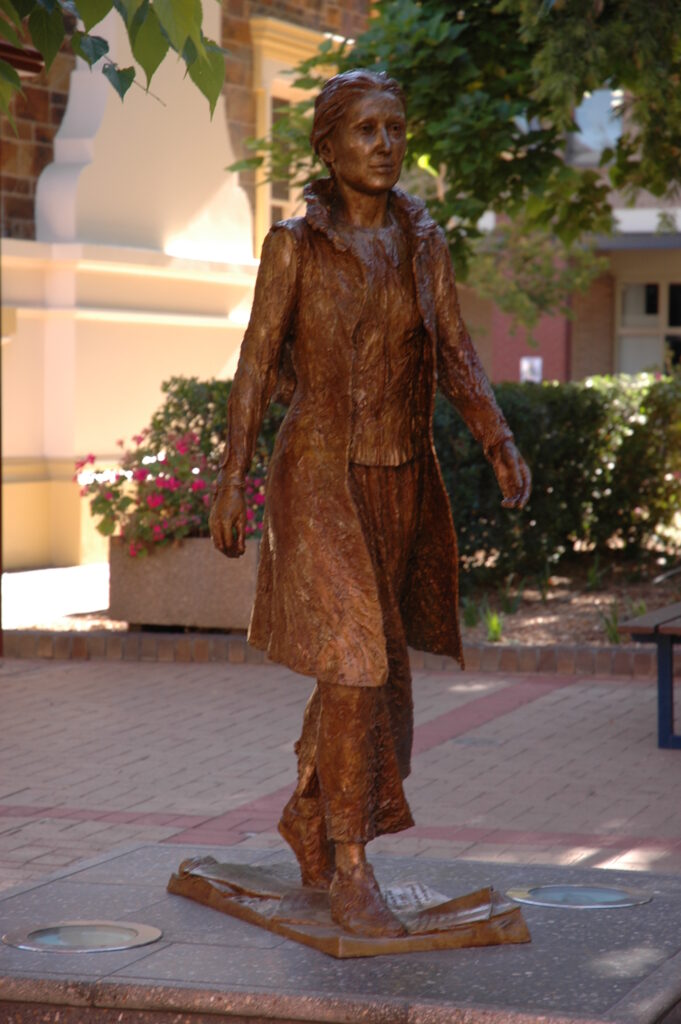
From these beginnings have emerged generations of friendship and partnership between St. Mike’s and the Loretto Sisters. Sisters have studied at St. Mike’s, taught courses, served as chaplains, and ministered to students through the residences. This friendship and partnership, however, is not simply one for the history books. Today there continues to be strong collaboration through Loretto College and the Mary Ward Centre. We have shared interests and collaborate on interfaith dialogue. We participated together in a recent initiative at St. Basil’s Parish on Indigenous relations in the Church. And through Campus Ministry, we are actively working together to engage students in a process of listening and conversation for the 2023 Synod on Synodality.
While a student at Regis College, I had the privilege of working closely with colleagues at St. Mike’s on the Regis-USMC federation process. I prayed with students from St. Mike’s, journeying together through the Ignatian First Spiritual Exercises. I worked collaboratively with St. Mike’s students on events, and of course, I was fortunate to take theology courses through the Faculty of Theology. Each of these experiences has given me insight into our valued partnership, rooted in loving friendship and a desire for service.
As the Loretto Sisters and our Sisters in the Congregation of Jesus celebrate Mary Ward this week, giving thanks for her birth on January 23 (1585) and her death on January 30 (1645), we are also celebrating the joy of mission shared with centuries of companions, friends, and collaborators. We invite our friends at St. Mike’s to celebrate with us, to share in the reality of one woman’s vision and her desire to do all for the greater glory of God.
Read other InsightOut posts.
Sonal Castelino, xmcj is the Director of Campus Ministry at the University of St. Michael’s College.
An open door, a standing invitation
Belonging | Curiosity | Joy | Faith| Encounter | Connections | Festivals | Art | Rituals | Culture| Friendship | Justice | Openness | Wholeness | Integrity | Good News | Silence| Searching | Worship | Advocacy| Conversion | Grace | Dialogue | Community| Hope | Engagement | Mercy | Space | Love | Service | Listening | Safe | Vocation | Mentors | Liturgy | Truth | Home| Diversity | Challenging | Prayer| Life | Exploration | Beauty| Peace | Food | Tradition | Architecture | Growth | Laughter | Conversation | Kindness | Celebration | Experience | Leadership | Journey | Compassion | Change | Novelty | Goodness | Conversation

This random series of words comes from you! Well, some of you, with whom I have had the pleasure of meeting in the past six weeks, when we spoke of the place or the role Campus Ministry has played—or you would like to see play—in your life.
This list is by no means exhaustive but, at an initial look, shows the diversity of needs and expectations. Most of these words are relational and not solitary. I see a desire for community, a need to share, a want to be accompanied, a space where dreaming is possible.
I am honoured to be in this office and to witness clubs, discussion circles, associations, and friendships trying to create these spaces—spaces which seek to find life, growth, wholeness. I am here to support you to continue and for those who struggle to find this, to aid you in your searching.
Who am I?
I am Sonal, Director of Campus Ministry here at the University of St. Michael’s College. I was born and raised in the United Arab Emirates to immigrant parents. I was 18 years old when I moved to Canada—Mississauga, ON—for university. I arrived on campus, my new home away from home, in search of community, and was quickly able to find it through Residence Life and Campus Ministry. These supports gave me the courage needed to live new experiences, meet interesting people, and form meaningful friendships.
Life on campus enabled me to become more active in my faith and more curious about my place in the world, my relationship with God, my relationship to those around me. I wanted to find words to describe and name the interior movements going on within me—to be able to articulate my faith in an intelligible and accurate way while desiring to more deeply encounter this God who remains a mystery.
This turned me towards the study of theology. My hopes were twofold: to want to put my gifts to the service of young adults—especially on university campuses (I just love campus culture!) and to find a community of faith where I can plant roots, be challenged, grow and flourish, while enabling the community to do the same.
Through my studies and involvement in campus life, I found multiple support outlets—faith-based and secular; Christian and non-Christian; intellectual and service-oriented.
These outlets challenged me, encouraging me to grow and to move beyond my comfort level while also teaching me to be more comfortable and confident of myself. These experiences shaped me to allow myself to be touched by the hope and the hurt of the world and to work and pray as a response.
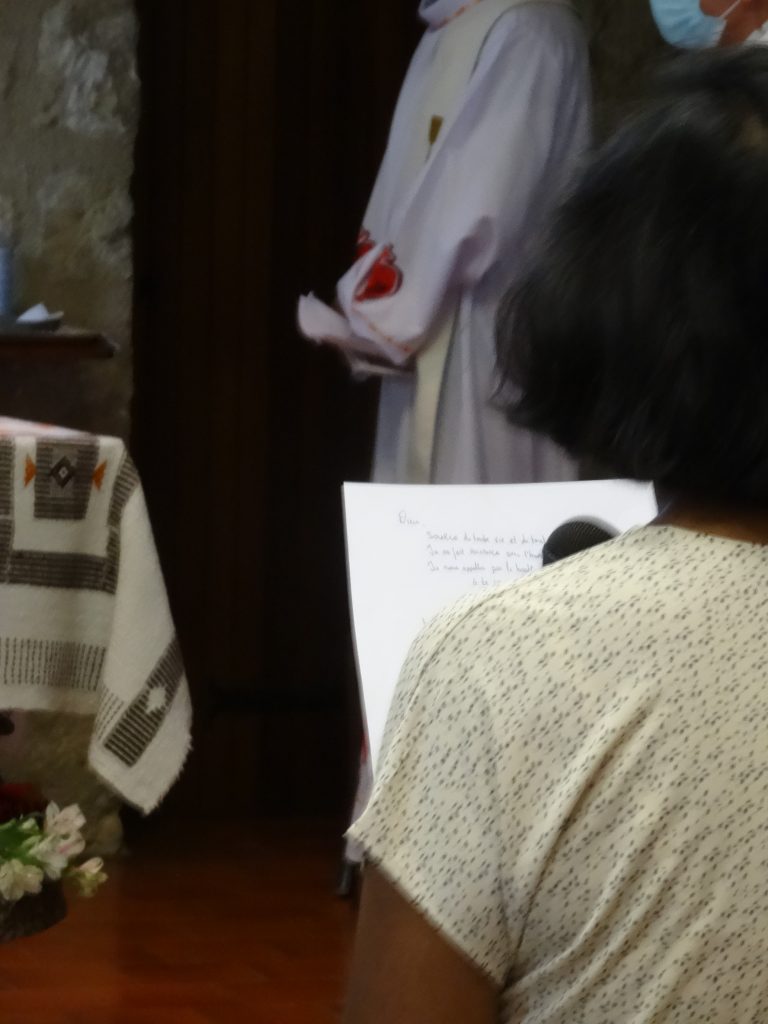
This interwoven spiritual, personal, and, eventually, professional journey (I worked in Campus Ministry at the Newman Centre and in Student Life at Regis College) pushed me to take another step—one of engagement, commitment in a more formal sense—religious life.
This summer, after three years of initial formation, I made temporary vows of chastity, poverty, and obedience with a religious congregation—La Xaviere Missionnaire du Christ Jesus (the Xaviere sisters), as a visible response to a personal desire, the desire being to be available to encounter God in my everyday life and to be a channel, enabling those around me to be open to encountering the mystery of God within themselves and in those around them.
This is my hope for Campus Ministry here at St. Mike’s as well! The list of words on top is beyond a to-do list. It is proof of life that is already flourishing and I hope that continues.
I wanted to share part of my story with you to invite you to reflect on your own experiences on campus, your story here at St. Mike’s—the joyful and the painful pieces, because they add up to make you!
I want to continue this conversation with you—hear of your story, how faith has been a part of it or not. My office is always open in Brennan Hall, Room 101. Drop by; I would love to meet you!
Read other InsightOut posts.
Ash Wednesday marks the beginning of the Season of Lent in the Catholic tradition and liturgical calendar. It is a season of penance, fasting, and almsgiving which prepares us for Christ’s Passion, Death and Resurrection (Holy Triduum), which culminates with the celebration of Easter Sunday.
Beginning on Ash Wednesday, our foreheads are marked with Ashes to humble our hearts and remind us that life on earth is only temporary and we acknowledge our mortality in the hope and promise of the Resurrection. We remember this when we are told, “Remember you are dust, and to dust you shall return”.
It is in the season of Lent that we are reminded of two major themes. It emphasizes a spirit of penance. Over the next forty days we draw closer to God’s Word and prayer, as we prepare to celebrate the paschal mystery. Secondly, Lent is also a time to reconcile our sins against God. We need to pay special attention to how we live out our faith and treat others, therefore we are reminded of the social and grave consequences to sin. Let us not forget that all is made known by God and that we cannot remove ourselves from the presence and love of God. Allow God to do wonderful things during this most holy season and be gracious and open in receiving His Grace and mercy.
And so we pray,
Lord God, your sons and daughters stand before You in humility and trust. Look always with compassion on us and heal our wounds. Stretch out your hand to save us and raise us up.
Keep us free from harm as members of Christ’s body, as sheep of your flock, and as children of your family. Do not allow evil or death to trimph over us, for you have raised us to new life in Baptism.
Hear Lord, our prayers and lead us back to your ways of Holiness. Protect us now and always, and may we receive openly your gift of unending love and divine mercy. Amen.
St. Michael the Archangel; pray for us.


